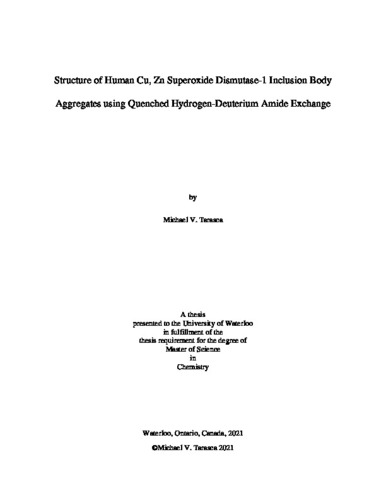| dc.contributor.author | Tarasca, Michael | |
| dc.date.accessioned | 2021-12-22 16:37:31 (GMT) | |
| dc.date.available | 2021-12-22 16:37:31 (GMT) | |
| dc.date.issued | 2021-12-22 | |
| dc.date.submitted | 2021-12-16 | |
| dc.identifier.uri | http://hdl.handle.net/10012/17804 | |
| dc.description.abstract | Inclusion bodies (IBs) are insoluble protein aggregates that can be formed within recombinant bacteria. These aggregates, once thought to be an obstacle in recombinant protein expression and purification, have recently gained attention to their potential applications in biotechnology and medicine. However, despite their attractive qualities, there have been little investigations into their high-resolution structure. Presented is the method quenched hydrogen-deuterium amide exchange (qHDX), a method in which solvent-exposed amide protons of IB aggregates are exchanged with deuterium, lyophilized, then dissolved in DMSO and observed by two-dimension nuclear magnetic resonance (NMR). This method allows one to probe the map the solvent-exposed and solvent-protected backbone amides of the aggregated protein.
qHDX was optimized on IBs of Cu, Zn superoxide dismutase-1 (SOD1), a homodimeric metalloenzyme that is associated with the development of neurodegenerative diseases, including amyotrophic lateral sclerosis (ALS). The IB structure of SOD1 was probed using various mutants across three different expression conditions. Remarkably, the mutants all adopt similar, extensive native-like structure with some amyloid features, despite large differences in protein stabilities and mutation types. These results hold true across all measured expression conditions. These findings are of broad significance for understanding cellular protein aggregation. The structural characteristics of SOD1 IBs and effects of mutations may be valuable for advancing rational design of IBs. qHDX is a powerful tool that has potential to pave the way for advancements in the field of protein engineering as an effective method to measure the high-resolution structure of in vivo protein aggregates. | en |
| dc.language.iso | en | en |
| dc.publisher | University of Waterloo | en |
| dc.subject | protein folding | en |
| dc.subject | aggregation | en |
| dc.subject | nuclear magnetic resonance | en |
| dc.subject | amide exchange | en |
| dc.subject | structure determination | en |
| dc.subject | method development | en |
| dc.title | Structure of Human Cu, Zn Superoxide Dismutase-1 Inclusion Body Aggregates using Quenched Hydrogen-Deuterium Amide Exchange | en |
| dc.type | Master Thesis | en |
| dc.pending | false | |
| uws-etd.degree.department | Chemistry | en |
| uws-etd.degree.discipline | Chemistry | en |
| uws-etd.degree.grantor | University of Waterloo | en |
| uws-etd.degree | Master of Science | en |
| uws-etd.embargo.terms | 0 | en |
| uws.contributor.advisor | Meiering, Elizabeth | |
| uws.contributor.affiliation1 | Faculty of Science | en |
| uws.published.city | Waterloo | en |
| uws.published.country | Canada | en |
| uws.published.province | Ontario | en |
| uws.typeOfResource | Text | en |
| uws.peerReviewStatus | Unreviewed | en |
| uws.scholarLevel | Graduate | en |

